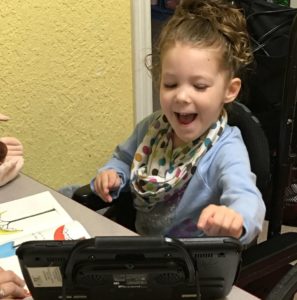 As a child nears his or her first birthday, parents begin to anxiously await their child’s first word. That first word marks the beginning of an exciting time of learning, where children learn to express their wants, needs, and ideas, and perhaps most importantly, say words like ‘mama,’ ‘daddy,’ and ‘I love you.’ Sometimes, however, that first word doesn’t come and parents must embark on a different, but just as amazing journey.
As a child nears his or her first birthday, parents begin to anxiously await their child’s first word. That first word marks the beginning of an exciting time of learning, where children learn to express their wants, needs, and ideas, and perhaps most importantly, say words like ‘mama,’ ‘daddy,’ and ‘I love you.’ Sometimes, however, that first word doesn’t come and parents must embark on a different, but just as amazing journey.
As a speech-language pathologist who works with children who have a wide variety of communication impairments, I have the opportunity to guide parents and children through this journey. I want to share a true story about a little girl who uses Augmentative and Alternative Communication (AAC) to communicate. At 8 months old, Kylee was diagnosed with bilateral closed lip schizencephaly and cerebral palsy. These diagnoses meant that she may never walk or talk. However, her family was desperate to communicate with her and determined to provide her with every opportunity possible.
When I met Kylee two years ago, she was unable to communicate at all. She was three years old and made no sounds other than crying. Searching for a way to help Kylee communicate her wants and needs, her mother brought her to Children’s Therapy TEAM, where I introduced her to AAC. AAC is a term that is used to describe various methods of communication that can be used to help individuals with communication impairments who are unable to reliably use verbal speech to communicate.
At first, Kylee used a picture exchange system where she requested wanted items or activities by selecting pictures velcroed in a book and handing them to her communication partner. As her vocabulary grew to over 50 words, it quickly became evident that another system was needed. It was a long process, but Kylee now has a high-tech AAC device, which is a computer that speaks as she pushes buttons on the screen. This computer gives Kylee access to over 3,000 words! When she first started using the device, she said only a few words, but now, she is able to formulate sentences, answer questions, and most importantly…tell us how much she likes cookies and ice cream!
Kylee’s success inspired me to build an AAC program at TEAM, so that other kids in Northwest Arkansas would have the opportunity to try various options for communication. When I became a pediatric speech-language pathologist, I aimed to make a positive difference in the lives of children and their families. After helping Kylee, it is clear that the determination of the children and their families are the ones making the difference in my life as they inspire me to continue finding ways to help every child learn to communicate.
WHAT IS AAC?
Augmentative and Alternative Communication (AAC) refers to methods of communication other than speech that can be used to help people with communication impairments who are unable to reliably use verbal speech to communicate. AAC can benefit a wide range of individuals (children and adults) with a wide range of diagnoses such as cerebral palsy, autism, developmental disability, and amyotrophic lateral sclerosis. AAC includes a wide variety of methods of communication, with or without external materials or equipment, such as vocalizations, facial expressions, gestures, sign language, pictures, books, and/or computers.
Lynsey Phillips, MS, CCC-SLP, serves as Director of Children’s Therapy TEAM’s AAC Program. She joined the TEAM family in 2009. Originally from Fayetteville, Lynsey graduated from the University of Arkansas and then went on to obtain her Master of Science in Bilingual Speech-Language Pathology from Arizona State University. Lynsey specializes in Autism Spectrum Disorders and serving bilingual populations. She is an active community volunteer with the Autism Involves Me (AIM) non-profit organization. She is currently a member of the AIM Board of Directors and serves as an AIM Event Coordinator. Lynsey notes, “I have a special place in my heart for individuals with autism and their families. It is a unique journey that requires a lot of support. I enjoy helping families make connections, get the resources they need, and have a place where they feel they belong.”
Lynsey is fluent in English and Spanish. She holds an English as a Second Language Endorsement (Arkansas Tech University, 2012).
Posted February 2017, Children’s Therapy TEAM

